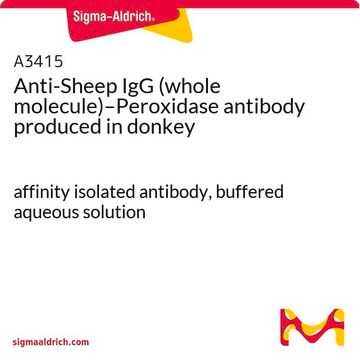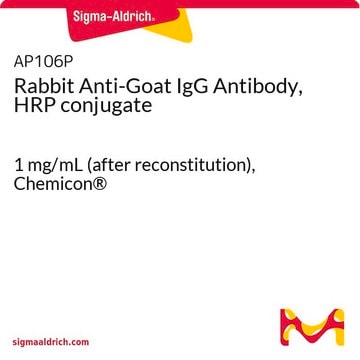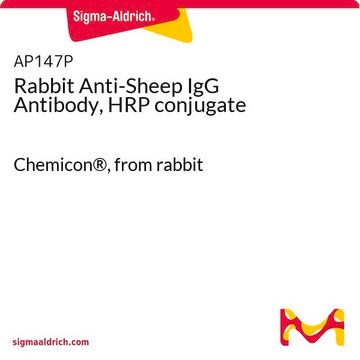Wichtige Dokumente
A9452
Anti-Goat/Sheep IgG−Peroxidase antibody, Mouse monoclonal
clone GT-34, purified from hybridoma cell culture
Synonym(e):
Monoclonal Anti-Goat/Sheep IgG
Größe auswählen
About This Item
Empfohlene Produkte
Biologische Quelle
mouse
Qualitätsniveau
Konjugat
peroxidase conjugate
Antikörperform
purified from hybridoma cell culture
Antikörper-Produkttyp
secondary antibodies
Klon
GT-34, monoclonal
Form
lyophilized powder
Speziesreaktivität
sheep, goat, bovine
Darf nicht reagieren mit
rat, canine, mouse, rabbit, guinea pig, chicken, horse, pig, feline, human
Verpackung
vial of 0.5 mL
Methode(n)
direct ELISA: 1:30,000
dot blot: 1:160,000 (chemiluminescent)
immunohistochemistry (formalin-fixed, paraffin-embedded sections): 1:100
Isotyp
IgG1
Lagertemp.
2-8°C
Posttranslationale Modifikation Target
unmodified
Suchen Sie nach ähnlichen Produkten? Aufrufen Leitfaden zum Produktvergleich
Verwandte Kategorien
Allgemeine Beschreibung
Mouse monoclonal anti-goat/sheep IgG-peroxidase antibody shows strong cross-reactivity with sheep IgG and cross-reacts with bovine IgG. No cross-reaction of the unconjugated monoclonal antibody is observed with human serum and tissue components. Moreover, the antibody does not react with the following species: guinea pig, rat, mouse, rabbit, horse, dog, chicken, pig and cat.
Anwendung
Biochem./physiol. Wirkung
Physikalische Form
Angaben zur Herstellung
Haftungsausschluss
Sie haben nicht das passende Produkt gefunden?
Probieren Sie unser Produkt-Auswahlhilfe. aus.
Signalwort
Warning
H-Sätze
Gefahreneinstufungen
Skin Sens. 1
Lagerklassenschlüssel
13 - Non Combustible Solids
WGK
WGK 2
Flammpunkt (°F)
Not applicable
Flammpunkt (°C)
Not applicable
Persönliche Schutzausrüstung
Eyeshields, Gloves, type N95 (US)
Hier finden Sie alle aktuellen Versionen:
Analysenzertifikate (COA)
Die passende Version wird nicht angezeigt?
Wenn Sie eine bestimmte Version benötigen, können Sie anhand der Lot- oder Chargennummer nach einem spezifischen Zertifikat suchen.
Besitzen Sie dieses Produkt bereits?
In der Dokumentenbibliothek finden Sie die Dokumentation zu den Produkten, die Sie kürzlich erworben haben.
Kunden haben sich ebenfalls angesehen
Active Filters
Unser Team von Wissenschaftlern verfügt über Erfahrung in allen Forschungsbereichen einschließlich Life Science, Materialwissenschaften, chemischer Synthese, Chromatographie, Analytik und vielen mehr..
Setzen Sie sich mit dem technischen Dienst in Verbindung.















